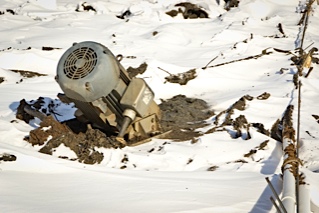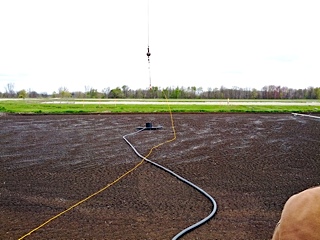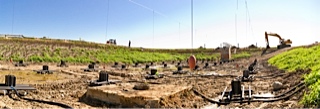We hope this case study educates our readers about the importance of wastewater lagoon mixing with regard to overcoming issues surrounding odor associated with extreme sludge buildup. With so much talk about aeration, DO, BOD, TSS, etc., oftentimes wastewater lagoon mixing is forgotten. After reading the scenario below (in Lake Odessa, MI, during 2012 and 2013), hopefully you’ll never underestimate the importance of wastewater lagoon mixing again.
The Problem
Lake Odessa, MI—The 0.65 Acre, 1.4M gallon sludge holding lagoon at the Lakewood

Wastewater Authority experienced extreme odor and settling issues when its two 50HP aspirating surface aerators failed to maintain an adequate dissolved oxygen (DO) content. As the wastewater lagoon became septic, solids rose from the bottom and formed a sludge mat at the surface more than a foot thick. This sludge layer caused the surface aerators to malfunction, leaving the entire lagoon without mixing or aeration. Read Causes & Effects of Wastewater Lagoon Sludge Explained for more about the detrimental effects of excess sludge.
With no aeration or lagoon mixing, sludge flowing from the adjacent oxidation ditch continued to accumulate. The resulting odor drew complaints from neighbors up to a mile away. Eventually, the Michigan DEQ (Department of Environmental Quality) mandated that the lagoon mixing and odor problems be solved at the Lakewood wastewater lagoon.

New Wastewater Lagoon Mixing and Aeration System
Dissatisfied with the performance of the surface aspirators in the extreme, sludge-heavy

environment, the plant operator took a new approach. Instead of installing a system that would create wastewater lagoon mixing in just a few locations, he wanted mixing distributed throughout the entire basin. Mixing from the top of the lagoon wastewater downward proved ineffective (likely due to the depth), so he wanted mixing from the bottom up. Most of all, he wanted all the motors located onshore for easy maintenance. Given the criteria, Triplepoint’s Lagoon Aeration System caught his attention.
Given the extreme conditions at his wastewater lagoon, the plant operator wanted to undergo a pilot test to ensure that the aerators would solve his lagoon mixing problems. In February 2012, four aerators were purchased for installation, and the broken surface aerators were removed. During installation, the floating sludge mat was discovered to be multiple feet thick in areas. In fact, the sludge had become so dense that the 160 lb. aerators would not fall through. An installer went out in a boat and attempted to push the aerator through, without success. Eventually it took a 600 lb. concrete weight attached to a crane to punch the aerators through the surface. Though they are not designed for this level of stress, none of the Triplepoint aerators was damaged in the process. (And, thankfully, all the aerators finally made it to the bottom of the lagoon.)

The Solution
Within the first hour of system startup, the mixing of the aerators began to break up the sludge mat. Moving a total of 28,000 gallons per minute, the four pilot aerators opened a hole spanning nearly half the lagoon. In addition, with their high oxygenation capacity of 5–7 lbs/O2/hp-hr, Triplepoint’s aeration system was able to noticeably reduce lagoon odors within one day of operation. Convinced of the mixing effectiveness of Triplepoint’s aeration system, the plant operator planned for a full aeration system implementation.
In July of 2013, an additional 44 aerators were installed in the Lakewood wastewater lagoon to create a “complete mix environment.” Fed air via three onshore 50hp blowers (one redundant), these wastewater lagoon aerators now transfer 3,840 pounds of oxygen into the water per day. Furthermore, lagoon mixing has been improved greatly. The lagoon now experiences a complete turnover once every four minutes, keeping all sludge solids in suspension. Most importantly, the aerators have kept the pond aerobic, with a strong dissolved oxygen content to maintain healthy BOD breakdown.

“Do you smell that?” the plant operator said after system start up, excited about the performance of his new aeration system.
“No,” responded a nearby installation technician.
“Me neither,” said the operator—that’s the way he likes it!
One More Win for Lakewood Wastewater Facility
Triplepoint’s Aeration System is able to achieve this level of mixing and odor reduction success using the same horsepower as the surface aeration system. This means that operation costs are the same or less, and maintenance costs are significantly less.
